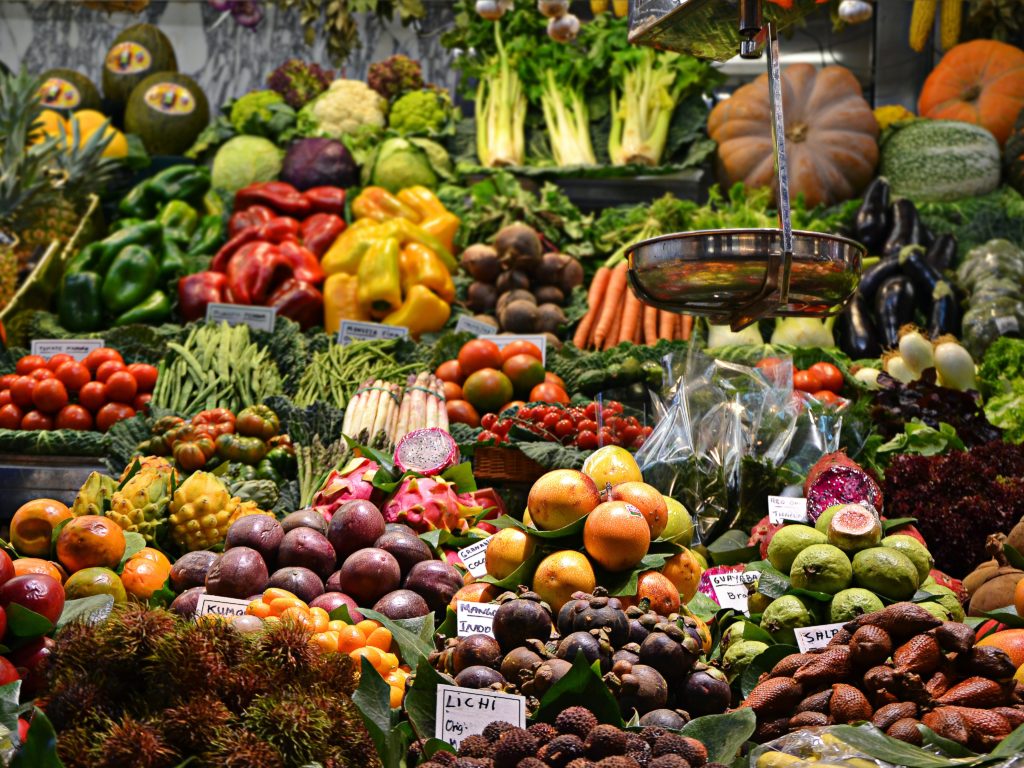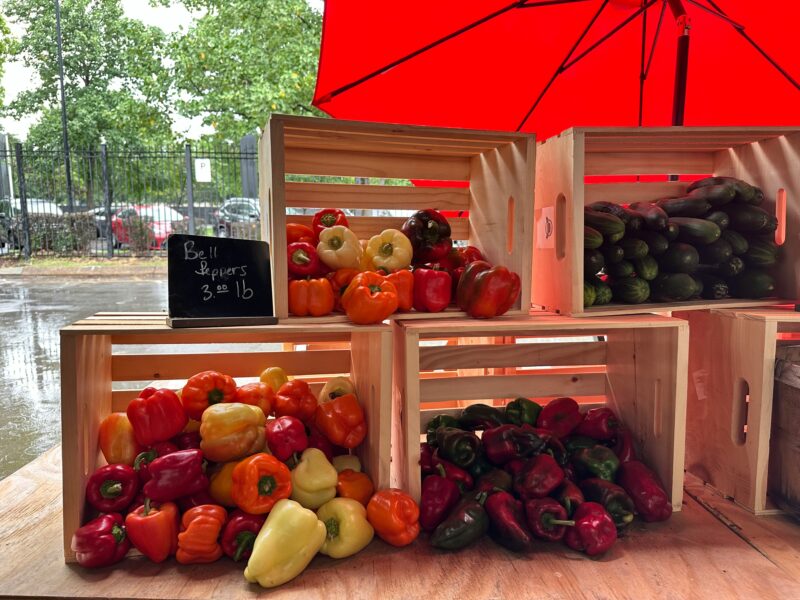Did you know 90% of Americans don’t get the recommended two to three servings a day of vegetables?
The recommended servings can seem like a lot especially when one accounts that for most vegetables one serving is a cup. But for raw, leafy vegetables like salad greens, a serving is two cups. To take this a step further: That 90% of Americans who are not eating enough veggies might also not be eating organic, because the survey didn’t ask that question.
If you’re signed up for a CSA, frequent a farmer’s market, or are simply inspired to add veggies to your plate for health reasons, you’ve come to the right place. Today we are highlighting creative ways to add more organic vegetables to your diet, along with recipes from our supporting organic brands to help you navigate this healthy habit with ease.
If vegetables aren’t a part of your daily fare, start by eating one extra vegetable a day. When you’ve gotten used to that, add another, and keep going.
Why veggies?
Let’s start with the importance of eating veggies, so you are empowered to add them to your daily diet.
Vegetables are a great source of healthy nutrients like fiber, potassium, folate, and vitamin A. They’re also a good cornerstone of any healthy diet since plants contain phytonutrients, which are important for boosting energy, promoting vibrant health, and protecting against aging. Vegetables are also high in antioxidants, which promote a healthy body as well as anti-aging benefits.
It’s crucial to understand the difference between nutrient-dense and calorie-dense foods. Calorie-dense foods contain a higher number of calories in a single serving. Nutrient-dense foods are rich in minerals, vitamins, antioxidants, and other nutrients, without added sugars and saturated fats. Most nutrient-dense foods are low in calories.
So eating healthy organic veggies at every meal is not only better for you nutritionally but can also help you achieve or maintain a healthy weight. Learn more about nutrients versus calories from Harvard Medical School here.
Why organic?
We’ve often joked that instead of counting calories, those who want to maintain a healthy body should count chemicals, too. When you choose certified organic, you’re skipping over 700 chemicals used in conventional food production. This means your body doesn’t have to process – essentially, detox – a heavy load of chemicals at every meal. So choosing organic is paramount.
Organic is the most heavily regulated food system in the U.S. Only organic guarantees no toxic persistent pesticides, synthetic fertilizers, or GMOs are used in production, and no antibiotics or growth hormones are given to livestock. Organic producers and processors are subject to rigorous announced – and unannounced – certification inspections by third-party inspectors to ensure they are producing and processing organic products in a way you and your family can trust.
Here are some facts about organic veggies:
- Eating organic vegetables could increase your antioxidant intake by 20% to 40% according to this study.
- A six-year study found more antioxidant activity and higher flavanol content in organic onions over conventional.
- A meta-analysis published in 2014 in the British Journal of Nutrition found that organic crops had significantly higher antioxidants than conventional crops, including higher levels of phenolic acids by 19%, flavanones by 69%, stilbenes by 28%, flavones by 26%, flavanols by 50%, and anthocyanins by 51%.
- A 2001 study published in The Journal of Alternative and Complementary Medicine looked at already published literature to compare the nutrient content in five common organic vegetables compared to those grown conventionally. In organic carrots, spinach, lettuce, potato, and cabbage there was significantly more vitamin C, iron, magnesium and phosphorus and fewer nitrates than the alternatively grown ones.
Get 15 more facts about why organic is better for you and the environment here.
Here are some ways to include more organics in your day, broken down meal by meal.
Breakfast
Start your day with organic vegetables, because they are rich in fiber, which helps fill you up and stay satisfied. And a veggie-filled breakfast will help you achieve your vegetable goals for the day. Three ways to kick off your day with organic veggies:
- Organic smoothie: Mix organic vegetables like spinach or kale into a smoothie to ensure you get your serving of leafy greens without sacrificing flavor.
- Organic egg dishes: Make an omelet filled with organic sautéed broccoli, artichoke, asparagus, spinach, onions, bell peppers, garlic, or kale. Egg dishes pair perfectly with sauteed veggies so try a scramble, frittata, or quiche using fresh herbs such as basil and oregano to satisfy both your taste buds and your veggie quota.
- Organic green juice: Having a 6-ounce glass of organic vegetable juice instead of fruit juice gives you a full serving of vegetables and helps you avoid 5 teaspoons or more of unnecessary sugar. Try coming up with a combination that pleases you, including celery, carrots, beets, lettuce, ginger, kale, spinach, and parsley. If green juice straight up is too bitter for you, try adding an organic green apple to sweeten the juice, without adding too much sugar. Vegetable juice must be consumed on an empty stomach so give yourself at least a 30-minute buffer before and after consuming green juice. When you drink vegetable juice too close to a meal you can cause indigestion and thus remove the nutritional benefits of consuming green juice.
Organic Veggie Breakfast Recipes
Uncle Matt’s Egg & Spinach Sauté with Fresh Herbs

Pete and Gerry’s Italian Frittata with Asparagus

Orgain’s Clean Green Smoothie Recipe
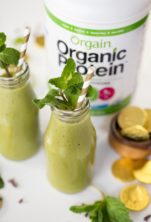
Applegate’s Bacon, Egg and Kale Bowl

Snacks
Processed foods can contain additives that wreak havoc on your health, so snack on veggies rather than processed foods. Here are three organic snack ideas to help you avoid the processed food aisle while on a break:
- Organic veggies with hummus or dips. Try carrots, bell peppers or cucumbers dipped in hummus.
- Organic veggies with nut butters. Try celery with your choice of nut butter.
- Organic veggie chips. Make eating vegetables fun and whip up homemade chips with beets, sweet potatoes, brussels sprouts, or kale. Baking thin slices or leaves with a little salt gives you a crunchy snack or side.
Organic Veggie Snack Recipes

Amy’s Risotto Stuffed Mushroom Caps

Forager Project’s reen Goddess Sour Cream Dip with Crudités and Chips
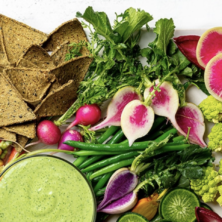
Stonyfield Yogurt Baked Zucchini Fries

Lunch
- Organic veggie wraps instead of tortillas. Don’t skip taco Tuesday. Instead, swap tortillas for organic lettuce to make a wrap. Butter lettuce leaves, cabbage leaves, lacinato kale and swiss chard all make good stand-ins.
- Organic veggie soup. Soup is very underrated from a health point of view, especially when it’s homemade. It’s intensely hydrating – it’s made with water, after all – and full of nutritious ingredients, like vegetables, beans, legumes, and lean meats. We recommend trying organic carrots, broccoli, spinach, kale, potatoes, green beans, and zucchini in your soup. You can also make purees, which can be high in vegetables and a way to switch up the texture and flavor profiles.
- Organic salads. A salad for lunch or dinner takes care of your recommended veggie serving for the day. Why not add a salad to both lunch and dinner? A small organic salad full of lettuces, avocado, cucumber, carrots, and fermented veggies will satisfy you and boost your veggie intake quickly.
Organic Veggie Lunch Recipes
Orgain’s Curried Carrot Cleansing Soup

Amy’s Gluten Free Veggie Burger Bowl
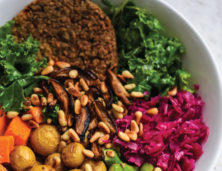
Watermelon and Radish Salad with Mint Vinaigrette

Asparagus and Morel Salad with Black Truffle Vinaigrette

Dinner
- Swap organic cauliflower for high-carb side dishes. If you haven’t tried cauliflower rice yet, you’re missing out on a savory experience. Swap cauliflower or cut the recipe in half when making white rice or mashed potatoes. You can go all cauliflower or split in two so you’re getting more vegetables without sacrificing delicious side dishes.
- Make organic veggie noodles. A spiralizer machine can turn zucchini or carrots into long, thin strands that resemble spaghetti. Combine with your favorite sauce and fresh veggies for a healthy and satisfying dinner. If you don’t have a spiralizer, you can use a vegetable peeler to create long “noodles” with your vegetables. During spaghetti squash season you can swap baked ones and enjoy it in your favorite Italian recipes.
- Add veggies to any dish. Think pasta primavera and add steamed vegetables to pasta dishes, like broccoli, spinach, carrots, and artichokes. Or make a basil and avocado pesto to top your pasta. Take this idea and combine vegetable noodles or spaghetti squash to satisfy the recommended serving in one meal.
Organic Veggie Dinner Recipes
Lundberg’s Vegan Thai Green Curry

Amy’s Mashed Potatoes with Roasted Brussels Sprouts

Forager Project’s Rustic Basil & Kale Pesto

Lundberg’s Rainbow Quinoa Slaw

Eating organic vegetables will make you feel good and keep your family – and the planet – healthy.
____________________________
If you liked this blog, please share it with a friend or tag us on social.

